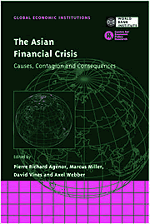Book contents
- Frontmatter
- Contents
- List of figures
- List of tables
- Preface
- List of conference participants
- Acknowledgements
- List of abbreviations and acronyms
- Introduction
- Part One General Accounts
- 1 The role of macroeconomic and financial sector linkages in East Asia's financial crisis
- Discussion
- 2 The Asian crisis: lessons from the collapse of financial systems, exchange rates and macroeconomic policy
- Discussion
- 3 Are capital inflows to developing countries a vote for or against economic policy reforms?
- Discussion
- 4 The Asian crisis: an overview of the empirical evidence and policy debate
- Discussion
- Part Two Theoretical Contributions
- Part Three Contagion
- Part Four Policy Responses
- Index
Discussion
from Part One - General Accounts
Published online by Cambridge University Press: 26 February 2010
- Frontmatter
- Contents
- List of figures
- List of tables
- Preface
- List of conference participants
- Acknowledgements
- List of abbreviations and acronyms
- Introduction
- Part One General Accounts
- 1 The role of macroeconomic and financial sector linkages in East Asia's financial crisis
- Discussion
- 2 The Asian crisis: lessons from the collapse of financial systems, exchange rates and macroeconomic policy
- Discussion
- 3 Are capital inflows to developing countries a vote for or against economic policy reforms?
- Discussion
- 4 The Asian crisis: an overview of the empirical evidence and policy debate
- Discussion
- Part Two Theoretical Contributions
- Part Three Contagion
- Part Four Policy Responses
- Index
Summary
While I was preparing my discussion of chapter 2, I had a strange dream. Some of you may think that this shows a shameful lack of concentration on my part. Be that as it may, the dream was striking. I dreamed that I was about to mark a large number of essays written by history undergraduates. The evident absurdity of this idea was not felt in the dream. The essays were concerned with the causes of the First World War. My first task was to map out a marking scheme, and my dream self felt entirely confident of my ability to do that.
One thing was clear. I would give low marks to any answer which advocated any single cause. Especially low marks would go to an essay which claimed that the war was caused by the assassination of the Arch-Duke in Sarajevo. The idea that the assassination of any individual, however prominent, could inescapably entail the outbreak of a Europewide war is completely ridiculous. Of course, a good answer could describe how the assassination triggered general conflict by being the occasion of a war between Austro-Hungary and Russia, which dragged in many other countries via the system of interlocking alliances which had maintained peace in Europe for over 40 years. The best answer would have to address that long peace, because one cannot reasonably claim that Europe's alliances made war inevitable in 1914, without explaining why very similar alliances had maintained peace for a length of time without precedent in modern Europe.
- Type
- Chapter
- Information
- The Asian Financial CrisisCauses, Contagion and Consequences, pp. 110 - 111Publisher: Cambridge University PressPrint publication year: 1999



